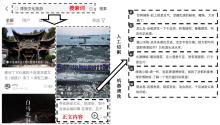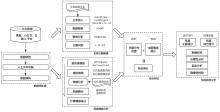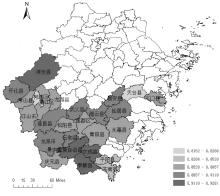| 1 |
中国政府网. 中共中央 国务院关于做好2023年全面推进乡村振兴重点工作的意见[EB/OL]. [2023-02-13].
|
| 2 |
佟伟铭, 郭加新, 徐维祥, 等. 县域视角下乡村发展要素转型对共同富裕的影响研究: 以浙江省为例[J]. 地理研究, 2023, 42(6): 1577-1597.
|
|
TONG W M, GUO J X, XU W X, et al. Research on the impact of factors of the rural development transformation on the common prosperity from the perspective of county areas: The case of Zhejiang province[J]. Geographical research, 2023, 42(6): 1577-1597.
|
| 3 |
王景盼. 以文旅融合发展助推乡村振兴[J]. 农业经济, 2023(2): 143-144.
|
|
WANG J P. Promoting rural revitalization with the integration of cultural tourism development[J]. Agricultural economy, 2023(2): 143-144.
|
| 4 |
王克岭, 黄姝菡, 段玲. 文化和旅游融合发展成效评估研究综述[J]. 经济问题探索, 2024(10): 152-164.
|
|
WANG K L, HUANG S H, DUAN L. A review of research on the effectiveness evaluation of culture and tourism integration[J]. Inquiry into economic issues, 2024(10): 152-164.
|
| 5 |
傅予, 曹屹楠, 王强. 基于图文多维特征融合的移动社交媒体用户生成内容信息采纳影响机制研究[J]. 情报资料工作, 2024, 45(1): 55-67.
|
|
FU Y, CAO Y N, WANG Q. Research on the influence mechanism of mobile social media user-generated content information adoption based on multidimensional feature fusion of images and texts[J]. Information and documentation services, 2024, 45(1): 55-67.
|
| 6 |
魏伟, 丁双莹, 刘方方, 等. 旅游信息科学: 多学科交叉融合背景下的理论与实践探究[J]. 地球信息科学学报, 2023, 25(9): 1747-1764.
|
|
WEI W, DING S Y, LIU F F, et al. Tourism information science: Research on theory and practice under the background of interdisciplinary integration[J]. Journal of geo-information science, 2023, 25(9): 1747-1764.
|
| 7 |
钟华美. 文旅融合背景下乡村旅游产业融合发展理论分析[J]. 资源开发与市场, 2020, 36(4): 421-426.
|
|
ZHONG H M. Theoretical analysis on integration and development of rural tourism industry under the background of cultural and tourism integration[J]. Resource development & market, 2020, 36(4): 421-426.
|
| 8 |
耿松涛, 张伸阳. 乡村振兴背景下乡村旅游与文化产业协同发展研究[J]. 南京农业大学学报(社会科学版), 2021, 21(2): 44-52.
|
|
GENG S T, ZHANG S Y. On rural tourism and cultural industry coordinated development under the background of rural revitalization[J]. Journal of Nanjing agricultural university (social sciences edition), 2021, 21(2): 44-52.
|
| 9 |
贺广景. 文旅融合背景下的乡村旅游文化发展路径: 评《文旅融合中的乡村旅游可持续发展研究》[J]. 热带作物学报, 2021, 42(2): 615.
|
|
HE G J. The development path of rural tourism culture under the background of the integration of literature and tourism: Comment on research on the sustainable development of rural tourism in the integration of literature and tourism[J]. Chinese journal of tropical crops, 2021, 42(2): 615.
|
| 10 |
文华, 刘英, 陈凯达. 乡村文化旅游产业赋能乡村振兴路径研究[J]. 草业科学, 2022, 39(9): 1968-1978.
|
|
WEN H, LIU Y, CHEN K D. Study on rural the path of cultural tourism industry enabling rural revitalization[J]. Pratacultural science, 2022, 39(9): 1968-1978.
|
| 11 |
辛本禄, 刘莉莉. 乡村旅游赋能乡村振兴的作用机制研究[J]. 学习与探索, 2022(1): 137-143, 2.
|
|
XIN B L, LIU L L. Study on the mechanism of rural tourism empowering rural revitalization[J]. Study & exploration, 2022(1): 137-143, 2.
|
| 12 |
万小妹. 数字文旅赋能乡村旅游高质量发展研究[J]. 农村经济与科技, 2022, 33(9): 107-110.
|
|
WAN X M. Research on digital travel empowering high-quality development of rural tourism[J]. Rural economy and science-technology, 2022, 33(9): 107-110.
|
| 13 |
张鑫, 蔡籽焓. 冀中非物质文化遗产与乡村文化旅游协同发展研究[J]. 农业经济, 2023(4): 141-142.
|
|
ZHANG X, CAI Z H. Research on the coordinated development of intangible cultural heritage and rural cultural tourism in central Hebei Province[J]. Agricultural economy, 2023(4): 141-142.
|
| 14 |
苏兰兰, 王清智, 任贇婧. 开封市余店民俗文化村乡村旅游高质量发展路径研究[J]. 西部旅游, 2024(22): 47-49.
|
|
SU L L, WANG Q Z, REN B /Y)J. Study on the high-quality development path of rural tourism in Yudian folk culture village of Kaifeng City[J]. Western travel, 2024(22): 47-49.
|
| 15 |
王琪延, 杜治仙. 中国乡村文旅发展与乡村振兴耦合协调研究[J]. 企业经济, 2025, 44(1): 57-67.
|
|
WANG Q Y, DU Z X. Research on coupling and coordination of rural cultural tourism development and rural revitalization in China[J]. Enterprise economy, 2025, 44(1): 57-67.
|
| 16 |
郑倩倩, 唐承财, 张瑛. 乡村文旅融合发展研究综述[J]. 地理与地理信息科学, 2024, 40(2): 126-133.
|
|
ZHENG Q Q, TANG C C, ZHANG Y. Review of research on the integrated development of rural culture and tourism[J]. Geography and geo-information science, 2024, 40(2): 126-133.
|
| 17 |
张新成, 高楠, 王琳艳, 等. 文化和旅游产业融合发展成效评估研究综述: 关系辨识、理论发展与体系重构[J]. 旅游科学, 2023, 37(4): 19-36.
|
|
ZHANG X C, GAO N, WANG L Y, et al. A review of cultural and tourism industry integration development effectiveness evaluation: Relation identification, theory development and system reconstruction[J]. Tourism science, 2023, 37(4): 19-36.
|
| 18 |
杜锦, 苗长虹, 许家伟, 等. 文旅融合背景下历史街区更新成效评估及提升路径研究: 以开封市三个历史街区为例[J]. 自然资源学报, 2025, 40(1): 164-180.
|
|
DU J, MIAO C H, XU J W, et al. Evaluation and enhancement of historic district regeneration effectiveness in the context of cultural-tourism integration: A case study of three historic districts in Kaifeng[J]. Journal of natural resources, 2025, 40(1): 164-180.
|
| 19 |
陈昱. 文化和旅游赋能乡村振兴效果评估体系构建研究: 基于全国127个县(乡村)文旅发展数据的实证分析[J]. 价格理论与实践, 2024(1): 119-123, 214.
|
|
CHEN Y. Research on the theoretical framework and evaluation system of rural revitalization from the perspective of culture and tourism: An empirical analysis based on 127 counties(villages) in China[J]. Price: Theory & practice, 2024(1): 119-123, 214.
|
| 20 |
丁华, 杨超, 王鹏飞. 红色旅游重点县域文旅融合评价体系构建与成效评估[J]. 价格理论与实践, 2024(7): 159-165, 223.
|
|
DING H, YANG C, WANG P F. Research on the construction of evaluation system and effectiveness assessment of culture and tourism integration in key red tourism counties[J]. Price: theory & practice, 2024(7): 159-165, 223.
|
| 21 |
许春晓, 胡婷. 文化旅游资源分类赋权价值评估模型与实测[J]. 旅游科学, 2017, 31(1): 44-56, 95.
|
|
XU C X, HU T. On value-estimating model and measurement of type-based weighting of cultural tourism resources[J]. Tourism science, 2017, 31(1): 44-56, 95.
|
| 22 |
解瑞金, 胡运红, 张恒. 基于灰色评价模型的山西省城市文化旅游业竞争力评价[J]. 数学的实践与认识, 2020, 50(6): 256-263.
|
|
XIE R J, HU Y H, ZHANG H. Evaluation of urban cultural tourism competitiveness in Shanxi Province based on grey evaluation model[J]. Mathematics in practice and theory, 2020, 50(6): 256-263.
|
| 23 |
袁渊, 于凡. 文化资源、旅游产业和经济发展耦合协调水平评价: 以50个重点旅游城市为例[J]. 统计与决策, 2024, 40(11): 114-119.
|
|
YUAN Y, YU F. Evaluation on the coupling and coordination level of cultural resources, tourism industry and economic development: A case study of 50 key tourism cities[J]. Statistics & decision, 2024, 40(11): 114-119.
|
| 24 |
YUAN X H. Evaluation of rural tourism development level using BERT-enhanced deep learning model and BP algorithm[J]. Scientific reports, 2024, 14(1): 25748.
|
| 25 |
VIÑÁN-LUDEÑA M S, DE CAMPOS L M. Discovering a tourism destination with social media data: BERT-based sentiment analysis[J]. Journal of hospitality and tourism technology, 2022, 13(5): 907-921.
|
| 26 |
赖晓凡, 谢嘉茜, 王心蕊. 乡村旅游景区质量要素及其对游客满意度的影响: 基于可解释神经网络的Kano模型[J/OL]. 旅游科学, 2024: 1-18.
|
|
LAI X F, XIE J Q, WANG X R. Quality factors of rural tourist attraction and their impacts on tourist satisfaction: Based on Kano model with explainable neural network[J/OL]. Tourism science, 2024: 1-18.
|
| 27 |
张大钊, 李显正, 赵振斌, 等. 基于LDA制图分析的古镇旅游地游客商业化体验及空间结构: 以大理古城为例[J]. 经济地理, 2023, 43(8): 200-209.
|
|
ZHANG D Z, LI X Z, ZHAO Z B, et al. Commercial experience and spatial structure of tourists in ancient town based on LDA mapping analysis: A case study of Dali ancient city[J]. Economic geography, 2023, 43(8): 200-209.
|
| 28 |
CAO Z, XU H, TEO B S. Sentiment of Chinese tourists towards Malaysia cultural heritage based on online travel reviews[J]. Sustainability, 2023, 15(4): 3478.
|
| 29 |
施琳霞. 解锁浙江省山区26县共同富裕的新“打开方式”[N]. 江南游报, 2024-06-20: 14.
|
| 30 |
王玮芹, 汪聪聪, 王益澄, 等. 浙江县域文化资源与旅游经济的空间错位分析[J]. 资源开发与市场, 2022, 38(3): 344-349.
|
|
WANG W Q, WANG C C, WANG Y C, et al. Spatial mismatch analysis of cultural resources and tourism economy in 89 counties of Zhejiang Province[J]. Resource development & market, 2022, 38(3): 344-349.
|
| 31 |
刘卿文, 朱丽男. 乡村旅游特色小镇的勃兴及去同质化困境的破解路径[J]. 农业经济, 2021(7): 45-47.
|
|
LIU Q W, ZHU L N. The prosperity of characteristic towns in rural tourism and the solution to the dilemma of homogenization[J]. Agricultural economy, 2021(7): 45-47.
|
| 32 |
邱均平, 孙月瑞. 基于文本挖掘的高校环境在线评论研究[J]. 图书馆理论与实践, 2021(5): 16-22.
|
|
QIU J P, SUN Y R. Research on university environment online review based on text mining[J]. Library theory and practice, 2021(5): 16-22.
|
| 33 |
GROOTENDORST M. BERTopic: Neural topic modeling with a class-based TF-IDF procedure[J/OL]. arXiv: 2203.05794, 2022.
|
| 34 |
EGGER R, YU J. A topic modeling comparison between LDA, NMF, Top2Vec, and BERTopic to demystify twitter posts[J]. Frontiers in sociology, 2022, 7: 886498.
|
| 35 |
CUI Y M, CHE W X, LIU T, et al. Pre-training with whole word masking for Chinese BERT[C]. IEEE/ACM Transactions on Audio, Speech, and Language Processing, 2021, 29: 3504-3514.
|
| 36 |
蔡汶兴, 李兴东. 基于BERT模型的景区评论情感分析[J]. 贵州大学学报(自然科学版), 2021, 38(2): 57-60.
|
|
CAI W X, LI X D. Sentiment analysis of scenic spot comments based on BERT[J]. Journal of Guizhou University (natural sciences), 2021, 38(2): 57-60.
|
| 37 |
刘民坤, 任莉莉, 周冰倩. 旅游发展何以驱动乡村振兴中“治理有效”[J/OL]. 旅游科学, 2024: 1-23.
|
|
LIU M K, REN L L, ZHOU B Q. How tourism development drives "effective governance" in rural revitalisation[J/OL]. Tourism science, 2024: 1-23.
|
| 38 |
KUMAR S, SAHOO S, ALI F, et al. Rise of fsQCA in tourism and hospitality research: A systematic literature review[J]. International journal of contemporary hospitality management, 2024, 36(7): 2165-2193.
|
| 39 |
PEER C F. Building better causal theories: A fuzzy set approach to typologies in organization research(article)[J]. Academy of management journal, 2011, 54(2): 393-420.
|












